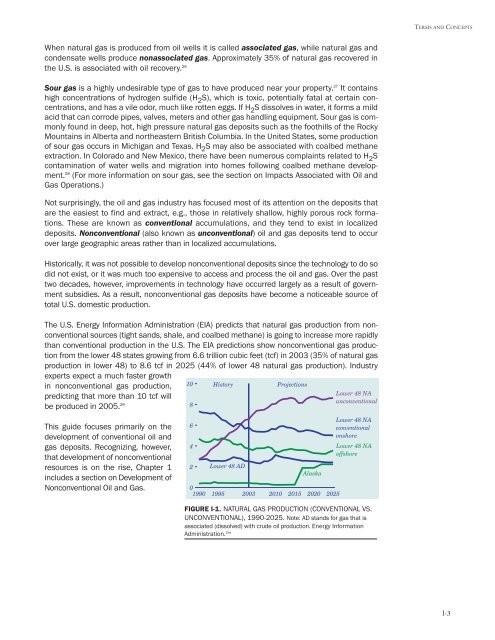Oil and Gas at Your Door? (2005 Edition) - Earthworks
Oil and Gas at Your Door? (2005 Edition) - Earthworks
Oil and Gas at Your Door? (2005 Edition) - Earthworks
You also want an ePaper? Increase the reach of your titles
YUMPU automatically turns print PDFs into web optimized ePapers that Google loves.
TERMS AND CONCEPTS<br />
When n<strong>at</strong>ural gas is produced from oil wells it is called associ<strong>at</strong>ed gas, while n<strong>at</strong>ural gas <strong>and</strong><br />
condens<strong>at</strong>e wells produce nonassoci<strong>at</strong>ed gas. Approxim<strong>at</strong>ely 35% of n<strong>at</strong>ural gas recovered in<br />
the U.S. is associ<strong>at</strong>ed with oil recovery. 26<br />
Sour gas is a highly undesirable type of gas to have produced near your property. 27 It contains<br />
high concentr<strong>at</strong>ions of hydrogen sulfide (H 2 S), which is toxic, potentially f<strong>at</strong>al <strong>at</strong> certain concentr<strong>at</strong>ions,<br />
<strong>and</strong> has a vile odor, much like rotten eggs. If H 2 S dissolves in w<strong>at</strong>er, it forms a mild<br />
acid th<strong>at</strong> can corrode pipes, valves, meters <strong>and</strong> other gas h<strong>and</strong>ling equipment. Sour gas is commonly<br />
found in deep, hot, high pressure n<strong>at</strong>ural gas deposits such as the foothills of the Rocky<br />
Mountains in Alberta <strong>and</strong> northeastern British Columbia. In the United St<strong>at</strong>es, some production<br />
of sour gas occurs in Michigan <strong>and</strong> Texas. H 2 S may also be associ<strong>at</strong>ed with coalbed methane<br />
extraction. In Colorado <strong>and</strong> New Mexico, there have been numerous complaints rel<strong>at</strong>ed to H 2 S<br />
contamin<strong>at</strong>ion of w<strong>at</strong>er wells <strong>and</strong> migr<strong>at</strong>ion into homes following coalbed methane development.<br />
28 (For more inform<strong>at</strong>ion on sour gas, see the section on Impacts Associ<strong>at</strong>ed with <strong>Oil</strong> <strong>and</strong><br />
<strong>Gas</strong> Oper<strong>at</strong>ions.)<br />
Not surprisingly, the oil <strong>and</strong> gas industry has focused most of its <strong>at</strong>tention on the deposits th<strong>at</strong><br />
are the easiest to find <strong>and</strong> extract, e.g., those in rel<strong>at</strong>ively shallow, highly porous rock form<strong>at</strong>ions.<br />
These are known as conventional accumul<strong>at</strong>ions, <strong>and</strong> they tend to exist in localized<br />
deposits. Nonconventional (also known as unconventional) oil <strong>and</strong> gas deposits tend to occur<br />
over large geographic areas r<strong>at</strong>her than in localized accumul<strong>at</strong>ions.<br />
Historically, it was not possible to develop nonconventional deposits since the technology to do so<br />
did not exist, or it was much too expensive to access <strong>and</strong> process the oil <strong>and</strong> gas. Over the past<br />
two decades, however, improvements in technology have occurred largely as a result of government<br />
subsidies. As a result, nonconventional gas deposits have become a noticeable source of<br />
total U.S. domestic production.<br />
The U.S. Energy Inform<strong>at</strong>ion Administr<strong>at</strong>ion (EIA) predicts th<strong>at</strong> n<strong>at</strong>ural gas production from nonconventional<br />
sources (tight s<strong>and</strong>s, shale, <strong>and</strong> coalbed methane) is going to increase more rapidly<br />
than conventional production in the U.S. The EIA predictions show nonconventional gas production<br />
from the lower 48 st<strong>at</strong>es growing from 6.6 trillion cubic feet (tcf) in 2003 (35% of n<strong>at</strong>ural gas<br />
production in lower 48) to 8.6 tcf in 2025 (44% of lower 48 n<strong>at</strong>ural gas production). Industry<br />
experts expect a much faster growth<br />
in nonconventional gas production,<br />
predicting th<strong>at</strong> more than 10 tcf will<br />
be produced in <strong>2005</strong>. 29<br />
10<br />
8<br />
History<br />
Projections<br />
Lower 48 NA<br />
unconventional<br />
This guide focuses primarily on the<br />
development of conventional oil <strong>and</strong><br />
gas deposits. Recognizing, however,<br />
th<strong>at</strong> development of nonconventional<br />
resources is on the rise, Chapter 1<br />
includes a section on Development of<br />
Nonconventional <strong>Oil</strong> <strong>and</strong> <strong>Gas</strong>.<br />
6<br />
4<br />
2<br />
Lower 48 AD<br />
Alaska<br />
0<br />
1990 1995 2003 2010 2015 2020 2025<br />
Lower 48 NA<br />
conventional<br />
onshore<br />
Lower 48 NA<br />
offshore<br />
FIGURE I-1. NATURAL GAS PRODUCTION (CONVENTIONAL VS.<br />
UNCONVENTIONAL), 1990-2025. Note: AD st<strong>and</strong>s for gas th<strong>at</strong> is<br />
associ<strong>at</strong>ed (dissolved) with crude oil production. Energy Inform<strong>at</strong>ion<br />
Administr<strong>at</strong>ion. 29a<br />
I-3




